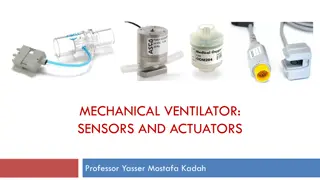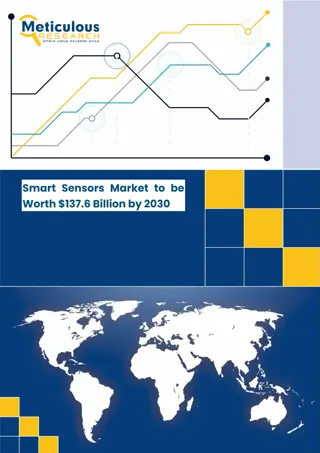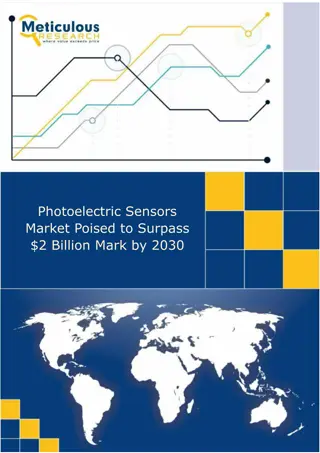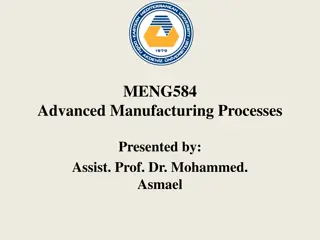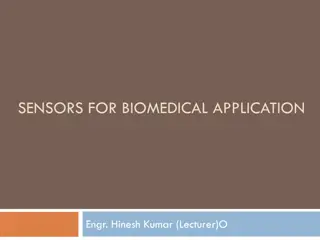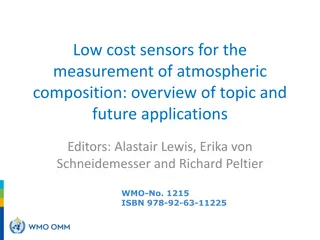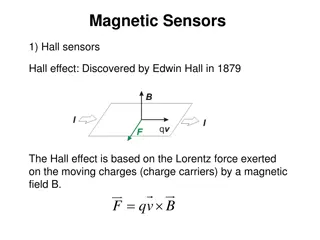Electrochemical & Conductometric Sensors
In the world of engineering, sensors play a crucial role. Electrochemical sensors utilize modified electrodes and electrolytes for specific analyte detection, while conductometric sensors measure electrolytic conduction changes in solutions. Explore the working principles, applications, and importance of these sensors in various fields such as environmental monitoring, healthcare, and agriculture.
Download Presentation

Please find below an Image/Link to download the presentation.
The content on the website is provided AS IS for your information and personal use only. It may not be sold, licensed, or shared on other websites without obtaining consent from the author.If you encounter any issues during the download, it is possible that the publisher has removed the file from their server.
You are allowed to download the files provided on this website for personal or commercial use, subject to the condition that they are used lawfully. All files are the property of their respective owners.
The content on the website is provided AS IS for your information and personal use only. It may not be sold, licensed, or shared on other websites without obtaining consent from the author.
E N D
Presentation Transcript
K.S. SCHOOL OF ENGINEERING AND MANAGEMENT, BENGALURU-109 Dr. Anitha R. Assistant Professor Department of Applied Science KSSEM, Bengaluru-560109
Electrochemical Sensors Transducer of an electrochemical sensor consists of working or sensing electrode, electrolyte, counter electrode and reference electrode. The sensing electrode has a chemically modified surface. This modification ensures the selectivity, facilitating the reduction or oxidation of the analyte. The electrolyte is part of the electric circuit of an electrochemical sensor system. The role of the electrolyte is to transport charge within the sensor. Working principle of an electrochemical sensor: Diffusion of the analyte to the electrode / electrolyte interface (in the liquid phase) Adsorption onto the electrode surface. Electrochemical reaction with electron transfer. Desorption of the products. Diffusion of the products away from the reaction zone to the bulk of electrolyte or gas phase.
Applications of electrochemical sensors: The oxygen sensor is used for detection of dissolved oxygen in water boiler and to monitor dissolved oxygen concentration in metal melts, glasses and in hydrogen fuel. They are used in security and defense applications like detection of toxic gases, warfare agents etc. They are used in water analysis and environmental monitoring like measurement of toxic metal concentration in water, detection of oxides of nitrogen and sulphur, CO, pH of water etc. `They are used in diagnostic and health care applications like in-situ monitoring of glucose serum uric acid, blood Ca2+, Fe2+ etc. They are used in soil parameter analysis, evaluation, and in agriculture application.
Conductometric sensors: It is based on measurement of physical properties of a homogeneous bulk solution. Here the electrodes are just used to measure change in electrolytic conduction of an electrolyte and they do not provide surface for any reaction. The electrodes used in conductivity sensor is called conductivity cell which is made up of two Platinum electrode kept 1cm apart and the volume between two electrodes is 1Cm3. Conductivity meter Pt Electrode 1cm Working principle of an Conductometric sensor: 1. The principle underlying conductometric sensor is the substitution of ions of one mobility by ions of another mobility. Therefore, the conductance of a solution depends on the number and mobility of ions. 2. There will be change in specific conductance when there is a change in number of ions or type of ion. This change is measured using conductivity cell. 1 ? ??????? 3. Conductance c is given by ? =
Applications of conductometric sensors It is used to estimate acids, bases and their mixtures in a sample. It is used to check the amount of ionic impurities in water sample. It is used in measuring acidity or alkalinity of sea water and fresh water. Conductometric biosensors are used in biomedical, environment monitoring, Biotechnology and agriculture related applications.
Optical Sensors Interaction of electromagnetic radiation with matter forms the basis of a broad range of analytical methods commonly known as spectrochemical method of analysis. Sensors based on the transduction of interaction of electromagnetic radiation with the chemical species are called as optical sensors. Working principle of an Opticalsensor: Optical transduction can be based on emission, absorption, reflection and scattering of light by the analyte. The optical signal arises from the interaction of the analyte with an incident radiation. The interaction could result in absorption, emission, scattering or reflection of light. The type of interaction depends on the wavelength of probing radiation and on the structure of the molecule in the analyte. The intensity of the radiation emitting from the analyte carries information on the concentration of the analyte. It is measured by the optoelectronic instrumentation.
The main components used in simple optical sensor are: 1. Light source 2. Wave length selector (filter) 3. Photodetector 4. Display system Applications of Optical sensors Optical sensors can be used in the determination of any chemical species which can interact with electromagnetic radiation. Optical sensors have been developed for a number of different types of chemical and biochemical molecules and ions Optical sensors find important and varied uses in environmental, biotechnological, food, pharmaceutical, medical and related applications. Optical fiber based (bio) sensors are used in screening of drugs, Detection of food borne pathogen, detection of explosives and environmental monitoring.
Sensors for the measurement of Dissolved Oxygen (DO): Molecular oxygen, O2 is slightly soluble in water. Only about 8mg of oxygen is soluble in one litre of water. This oxygen present in water in dissolved form is called dissolved oxygen. It is an important water quality parameter. Because aquatic living being depend upon this dissolved oxygen for their survival. Concentration of dissolved oxygen in boiled feed water plays an important role in corrosion of water boiler. In many industries, monitoring concentration of dissolved oxygen in metal melts and other materials is highly essential. Since measurement of dissolved oxygen by classical titration method is tedious, sensors for dissolved oxygen measurement plays an important role.
1) Optical sensor for measurement of dissolved oxygen: The main components of an optical sensor are semi permeable membrane, sensing element, light emitting diode (LED) and photodetector. The sensing element contains a luminescent dye that is immobilized on a gel matrix. When this dye is exposed to blue light, it moves to excited state and while returning back to ground state, it emits light with known intensity. When dissolved oxygen crosses the semipermeable membrane and interacts with the dye, it reduces the intensity of light emitted by dye. The intensity of light emitted by the dye is inversely proportional to dissolved oxygen concentration. Therefore, dissolved oxygen can be measured by measuring the decrease in intensity of light emitted by dye using a photodetector.
2) Electrochemical sensor for measurement of dissolved oxygen: In electrochemical DO sensor, two electrodes used are of dissimilar metals. Zinc or lead is used as anode and silver metal is used as an inert cathode. The difference in the potential between the anode and cathode should be more than 0.5V to reduce dissolved oxygen without an external applied potential. The electrolyte solution used is sodium chloride or any other inert electrolyte. When the electrode assembly is dipped in water to measure its dissolved oxygen, anode undergoes oxidation liberating electrons. At cathode, dissolved oxygen gets reduced. Reactions: At anode: 2 Zn 2 Zn2+ + 4 e At cathode: O2 + 2 H2O + 4 e 4 OH- Overall reaction: 2 Zn + O2 + 2 H2O 2 Zn(OH)2
NPTEL link: https://youtu.be/mYGfyO3sPxk?si=tC2uyXpaQEwlEFh9 https://youtu.be/I7XLmrpgqEs?si=jX_zANT5K56JWma9 https://youtu.be/d0-LywQVLPM?si=Q7QNqMklF_P4N0G- YouTube link: https://in.hach.com/oxygen/o2 https://youtu.be/hsGHQUrEfss?si=bEwBtBdHg3Noj QFP



